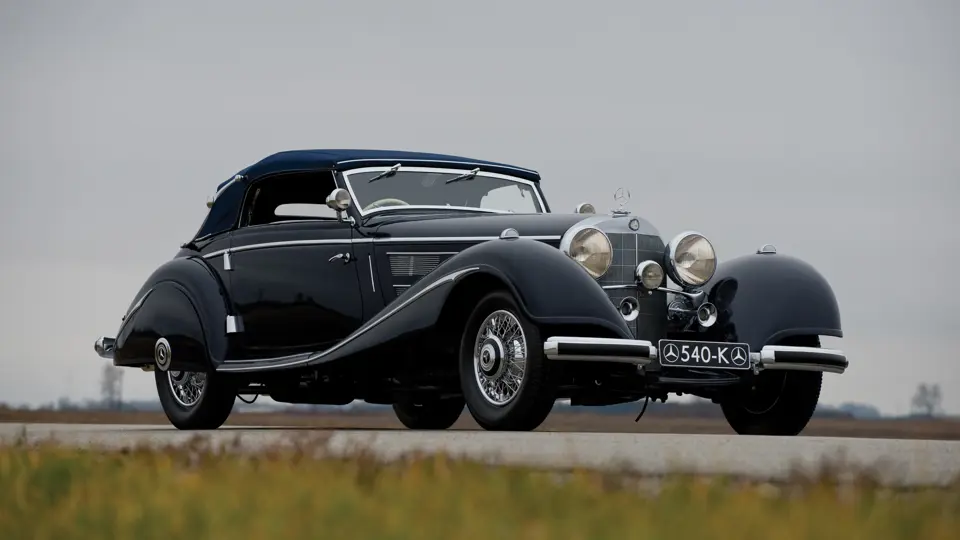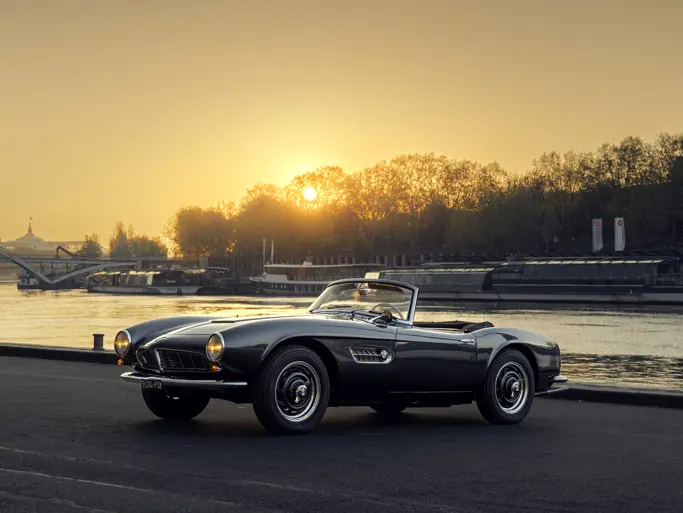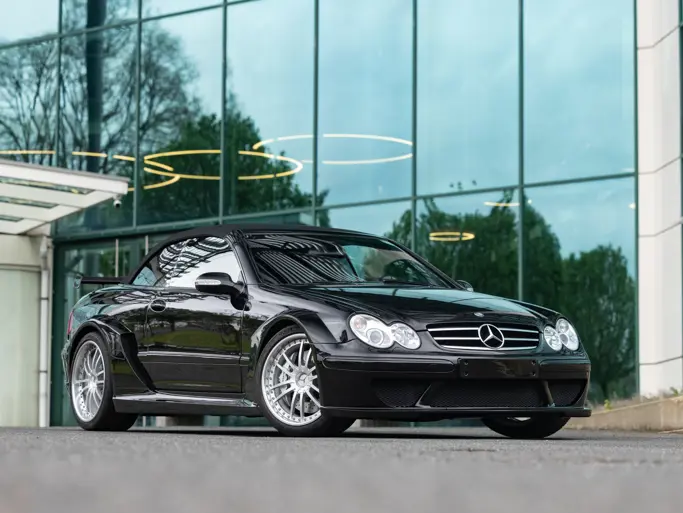115/180 bhp, 5,401 cc OHV supercharged inline eight-cylinder engine, four-speed manual gearbox, coil spring double-wishbone independent front suspension, swing axle rear suspension with coil springs, and four-wheel vacuum-assisted hydraulic drum brakes. Wheelbase: 2,980 mm (117.3")
- Built for 14th Maharajah of Indore
- 540K – the ultimate specification in desirable Cabriolet A form
- Concours-quality restoration by RM Auto Restoration
- Very original, complete car before restoration
- Multiple concours awards including Pebble Beach
The rulers of India’s Princely States were legendary for their love of fine motor cars. Typically possessed of great wealth, they bought lavishly, Rolls-Royce being a favourite marque, but their tastes were also wide-ranging and embraced such European cars as Mercedes and extended also to the American Duesenberg. Pre-eminent among these collectors of fine cars was the Maharajah of Indore.
Maharajah of Indore
Prior to the 1947 independence, the British Indian Empire comprised some 570 states, each ruled by a family dynasty. Indore, presently a city of about 1.5 million in the state of Madhya Pradesh in West Central India, was ruled during the Empire period by the Maratha Maharajas of the Holkar dynasty. His Highness Yeshwant Rao Holkar II ascended to the raj in 1926, becoming the 14th Maharajah upon the abdication of his father, H.H. Tukojirao Holkar.
With great riches from the fertile lands and industrial strength of his princely state, the new Maharajah indulged his cravings for jewels and automobiles. The latter became regarded as the most spectacular collection in India, comprising numerous cars, all ordered to his special tastes. In 1936 alone, he purchased three superb cars, a 4.5-litre Lagonda, a Bentley coupé and a supercharged Duesenberg, all painted in the Holkar colours of sunglow saffron and black. The Duesenberg, bearing the highest recorded Model J chassis number, was a long-wheelbase chassis bodied by J. Gurney Nutting as a streamlined art deco right-hand drive roadster. It is the most renowned of his cars but does not completely overshadow the remainder of the collection, which comprised such vehicles as a Hispano-Suiza J12, Bugatti, Delahaye, Pierce-Arrow and three Alfa Romeos. Most were painted in the dynasty colours and were equipped with red and blue running lights to indicate who was driving: red for the Maharajah, blue for his wife, the Maharani.
Chassis no. 154081
In 1937, H.H. Yeshwant Rao Holkar II ordered a Mercedes-Benz 540K from the factory in Untertürkheim, Germany. The 500K and 540K were a development of the Typ 380, which was the work of engineer Hans Nibel, who had developed a straight-eight of pushrod OHV design with 3,823 cc displacement. The new Typ 380 had all-independent suspension; a double-wishbone design with coil springs was used in front, with coil-sprung swing axles at the rear. The 380, however, proved to be somewhat underpowered, making 90 bhp when normally aspirated and 140 with the double-vane Roots-type supercharger – a bit underwhelming for a two-ton car. Nibel then came up with a larger 5-litre engine giving 100/160 bhp, introduced in 1934 as the Typ 500K, with “K” in this case meaning kompressor or supercharger. The wheelbase was extended to 3,290 mm (129.5 inches), and a range of cabriolets, roadsters and sedans was offered. Production of 500Ks totalled 354 over three years, followed by a further 419 540Ks with a larger, 5,401-cc engine.
Nibel’s magic with the engine brought results. The Autocar tested a 500K and clocked a 0-60 time of 16.5 seconds (remarkable for the mid-1930s) and a top speed of 100 mph, the blower letting out “its almost demoniacal howl” when it was engaged. Motor enthused, “here is a massive ‘unbreakable’ car capable of travelling indefinitely at high speed.” Another reporter cited the “sheer insolence of its power.”
For his Mercedes, His Highness specified factory Cabriolet A coachwork from the Daimler-Benz works at Sindelfingen. Styled and engineered by Hermann Ahrens, these svelte creatures display an unusual degree of élan for manufacturer-produced coachwork. Built on the short, 2,980 mm (117.3 inch) wheelbase, the Cabriolet A was a two-passenger drophead coupé, of which 83 were built. The 500K’s engine was enlarged to 5,401 cc and fitted with the same type Roots supercharger. This engaged at full throttle, raising horsepower from 115 to 180, or could be manually applied at part throttle if desired. The Maharajah drove spiritedly, so the 540K’s supercharger was just what he needed.
H.H. Yeshwant Rao Holkar II died in 1961. His daughter, Usha Devi, Maharaj Sahiba Holkar XV, currently holds the title as the 15th Maharani of Indore. Her father apparently gifted this Mercedes-Benz to someone during his lifetime. In the late 1970s, Christopher Renwick found it in a Mumbai motor agent’s shop. It had been left there years earlier by its then-owner and had not run in some time, but it gave the appearance of being a low-mileage car that had seen little use. Renwick recalls that, once recommissioned for the road, it drove very well. He was able to buy it, exported it to Britain and subsequently sold it to a German collector.
Some years later, it became available once more and was eventually exported to the United States, acquired by a prominent collector. The new owner immediately commissioned RM Auto Restoration to perform a nut-and-bolt rebuild, which was completed in July 2002. As acquired it had been once restored, painted a light shade of metallic blue, and was nearly complete. Even the vast majority of wood was intact and original. The only significant missing component was the spare tyre cover, which was constructed anew. In the comprehensive restoration the car was finished in a deep, deep midnight blue, with harmonising rich blue canvas hood. The odometer, which read 17,000 at the time, was reset to zero.
In its maiden outing, it garnered a quick third place in the 1925-39 Mercedes class at the 2002 Pebble Beach Concours d’Elegance. The following year it snared a triple crown at Meadow Brook Hall: the David Holls Memorial Designers Choice Award, the Most Significant Mercedes-Benz and the Founders Trophy for Best of Show.
As presented it has near-flawless brightwork, tan leather interior with blue carpet and a highly-varnished burl walnut dashboard with mother of pearl inlay. The VDO instruments are black-on-beige, illuminated in a light orange glow at night. Rear wheel spats and understated blackwall tyres complete the car’s elegant appearance, allowing the eye to focus on the car itself and not its rolling rubber.
In the world of collector cars, one seldom finds the opportunity to acquire an automobile as important as a pre-war supercharged Mercedes-Benz. Add to that a superb, award-winning restoration with royal provenance, and the astute collector is presented with a very rare opportunity indeed.
115/180 cv, motore otto cilindri in linea di 5.401 cc con valvole in testa e compressore, cambio manuale a quattro marce, sospensione anteriore a ruote indipendenti con due trapezi e ammortizzatori a molla, sospensione posteriore con assale indipendente e ammortizzatori a molla, freni a tamburo sulle quattro ruote con servofreno a depressione. Passo: 2.980 mm (117.3")
- Costruita per il 14° Maragià di Indore
- La massima evoluzione della 540K, con la desiderabile carrozzeria Cabriolet tipo A
- Restaurata in condizioni da concorso dalla RM Auto Restoration
- Restauro totale di una vettura assolutamente originale e completa
- Vincitrice di molti premi ai concorsi, incluso quello di Pebble Beach
I Signori dei Principati Indiani diventarono leggendari per il loro amore per le belle automobili. Notoriamente in possesso di grandi ricchezze, spendevano senza limiti: la Rolls-Royce era una delle marche preferite, ma i loro gusti erano variegati e spaziavano dalle vetture europee come le Mercedes, a quelle americane come le Duesenberg. Uno dei maggiori collezionisti fu il Maragià di Indore.
Il Maragià di Indore
Prima dell'indipendenza proclamata nel 1947, l'Impero Britannico delle Indie comprendeva circa 570 stati, ognuno governato da una dinastia di famiglia. Indore, attualmente una città di circa 1,5 milioni di abitanti nello stato di Madhya Pradesh nell'India centro-occidentale, era governata durante il periodo dell'Impero dal Maragià di Maratha della dinastia Holkar. Sua Altezza Yeshwant Rao Holkar II ascese al trono nel 1926, diventando il 14° Maragià dopo l'abdicazione di suo padre, Sua Altezza Tukojirao Holkar.
Dotato di grandi ricchezze grazie alle sue fertili terre e alla forza industriale del suo Principato, il nuovo Maragià assecondò la sua passione per i gioielli e le automobili. La sua divenne la più spettacolare collezione di automobili dell'India, composta da numerose vetture, tutte costruite secondo i suoi gusti particolari. Solo nel 1936 acquistò 3 superbe vetture, una Lagonda 4,5 litri, una Bentley coupé e una Duesenberg con compressore, tutte verniciate nei colori del casato Holkar, zafferano brillante e nero. La Duesenberg, l'ultimo numero di telaio del Modello J, era una versione a passo lungo, con guida a destra, carrozzata da J. Gurney Nutting con una carrozzeria roadster aerodinamica in stile art deco. E' la sua vettura più famosa anche se non oscurò completamente le altre automobili della collezione, che comprendeva una Hispano-Suiza J12, una Bugatti, una Delahaye, una Pierce-Arrow e tre Alfa Romeo. La maggior parte erano verniciate nei colori del casato ed erano equipaggiate con luci intermittenti rosse e blu che specificavano chi stesse guidando: rosse per il Maragià, blu per la sua consorte.
Il telaio n. 154081
Nel 1937, Sua Altezza Yeshwant Rao Holkar II ordinò una Mercedes-Benz 540K direttamente presso la fabbrica di Untertürkheim, in Germania. La 500K e la 540K erano l'evoluzione della Tipo 380, progettata dall'ingegnere Hans Nibel, che aveva sviluppato un motore di 3.823 cc 8 cilindri in linea con valvole in testa comandate da bilancieri. La nuova Tipo 380 aveva le sospensioni a ruote indipendenti, con due trapezi con ammortizzatori a molla all'anteriore e assale indipendente con ammortizzatori a molla al posteriore. La 380 si dimostrò sotto-motorizzata con 90 cv con l'alimentazione normale aspirata e 140 cv con il compressore a due lobi tipo Roots, sicuramente poco per una vettura di due tonnellate. Nibel passò quindi ad un più grosso motore di 5 litri, che forniva da 100 a 160cv, che fu presentato nel 1934 sulla 500K, dove “K” stava per kompressor, ovvero compressore. Il passo fu allungato a 3.290 mm e fu offerta una gamma completa di carrozzerie cabriolet, roadster e berline. La produzione totale in tre anni di 500K fu di 354 unità, quella della 540K, con il motore portato a 5.401 cc, fu di 419 esemplari.
La magia di Nibel con il motore produsse i suoi frutti. La rivista The Autocar provò una 500K accelerando da 0 a 100 km/h in 16,5 secondi (un notevole risultato a metà degli anni Trenta) e raggiungendo una velocità massima di oltre 160 km/h, con il compressore che emetteva un urlo demoniaco quando entrava in funzione. La rivista Motor era entusiasta: “è una vettura indistruttibile, capace di viaggiare ad alta velocità per un tempo indefinito.” Un altro giornalista scrisse di “pura arroganza della sua potenza.”
Sua Altezza richiese una carrozzeria Cabriolet Tipo A, costruita dalla fabbrica Daimler-Benz di Sindelfingen. Disegnate e progettate da Hermann Ahrens, queste creazioni mostrano uno slancio inusuale per una carrozzeria costruita in serie. Costruita sul telaio a passo corto di 2.980 mm, la Cabriolet A aveva due posti e fu costruita in 83 esemplari. Il motore 500K fu portato a 5.401 cc e dotato dello stesso compressore tipo Roots. A piena apertura dava da 115 a 180 cv, ma, volendo, poteva essere regolato manualmente con apertura parziale. Il Maragià guidava in modo focoso e la 540K era proprio quello di cui aveva bisogno.
Sua Altezza Yeshwant Rao Holkar II morì nel 1961. Sua figlia Usha Devi, Maharaj Sahiba Holkar XV, assunse il titolo di 15° Maragià di Indore. Sembra che suo padre, quando era ancora in vita, avesse regalato a qualcuno questa Mercedes-Benz, che alla fine degli anni Settanta fu ritrovata da Christopher Renwick in un salone di vendita a Mumbai. Era stata lasciata lì anni prima dal suo proprietario e non era utilizzata da tempo, ma dava l'impressione di essere una vettura poco usata e con pochi chilometri. Renwick ricorda che, appena rimessa su strada, funzionò molto bene. Egli la acquistò, la esportò in Gran Bretagna e la rivendette ad un collezionista tedesco.
Alcuni anni dopo, la vettura tornò sul mercato e fu quindi esportata negli USA, acquistata da un noto collezionista. Questi commissionò immediatamente alla RM Auto Restoration un restauro integrale, che fu completato nel luglio 2002. Quando era stata acquistata, la vettura aveva già ricevuto un precedente restauro, era stata riverniciata in blu chiaro metallizzato ed era praticamente completa. Anche la quasi totalità dei legni era intatta e originale. L'unico significativo particolare andato perduto era la copertura della ruota di scorta, che fu costruita nuova. Durante il completo restauro, la carrozzeria fu riverniciata in blu molto scuro, in armonia con una capote blu. Il contachilometri, sul quale si leggeva la cifra 17.000, fu portato a zero.
All'esordio in un concorso, quello di Pebble Beach del 2002, conquistò facilmente il terzo posto nella classe Mercedes 1925-1939. L'anno seguente, ottenne tre premi alla Meadow Brook Hall: il premio David Holls Memorial Designers Choice, quello per la Most Significant Mercedes-Benz e il Founders Trophy per la Best of Show.
Attualmente si presenta con cromature praticamente prive di difetti, interni in pelle marrone chiaro con tappetini blu e un cruscotto in radica di noce ben verniciata con intarsio in madreperla. Gli strumenti VDO, neri su fondo beige, sono illuminati di sera da una tenue luce arancione. I copriruota posteriori e i poco appariscenti pneumatici neri ben si adattano all'eleganza della vettura, permettendo di focalizzare l'attenzione sulle sue linee e non sulle gomme.
Nel mondo delle automobili da collezione, raramente si ha l'occasione di acquistare una vettura importante come una Mercedes-Benz ante-guerra con compressore; se a ciò si aggiunge il superbo restauro, in grado di vincere premi ai concorsi, e la regale provenienza, al collezionista più attento si presenta davvero una rarissima opportunità.



 | Cernobbio, Italy
| Cernobbio, Italy


